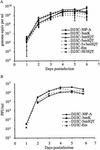American genotype structures decrease dengue virus output from human monocytes and dendritic cells
- PMID: 12634353
- PMCID: PMC150669
- DOI: 10.1128/jvi.77.7.3929-3938.2003
American genotype structures decrease dengue virus output from human monocytes and dendritic cells
Abstract
The dengue virus type 2 structures probably involved in human virulence were previously defined by sequencing the complete genome of both American and Southeast (SE) Asian genotype templates in patient serum (K. C. Leitmeyer et al., J. Virol. 73:4738-4747, 1999). We have now evaluated the effects of introducing a mutation in the envelope glycoprotein (E) gene and/or replacement of 5'- and 3'-nontranslated regions on dengue virus replication in human primary cell cultures. A series of chimeric infectious clones were generated containing different combinations of American and SE Asian genotype sequences. Some of the chimeric viruses had altered plaque morphology in mammalian cells; however, they replicated at similar rates in mosquito cells as measured by quantitative reverse transcription-PCR and plaque assay. Although susceptibility to virus infection varied from donor to donor in experiments using human macrophage and dendritic cells, we were able to measure consistent differences in viral RNA output per infected cell. Using this measurement, we demonstrated that the chimeric virus containing the E mutation had a lower virus output compared to the parental infectious clone. A larger reduction in virus output was observed for the triple mutant and the wild-type, American genotype virus from which chimeric inserts were derived. It appears that the three changes function synergistically, although the E mutation alone gives a lower output compared to the 5'- and 3'-terminal mutations. The data suggest that these changes may be responsible for decreased dengue virus replication in human target cells and for virulence characteristics during infection.
Figures





References
-
- Bosch, I., K. Xhaja, L. Estevez, G. Raines, H. Melichar, R. V. Warke, M. V. Fournier, F. A. Ennis, and A. L. Rothman. 2002. Increased production of interleukin-8 in primary human monocytes and in human epithelial and endothelial cell lines after dengue virus challenge. J. Virol. 76:5588-5597. - PMC - PubMed
-
- Burke, D. S., A. Nisalak, D. E. Johnson, and R. M. Scott. 1988. A prospective study of dengue infections in Bangkok. Am. J. Trop. Med. Hyg. 38:172-180. - PubMed
Publication types
MeSH terms
Substances
Grants and funding
LinkOut - more resources
Full Text Sources

